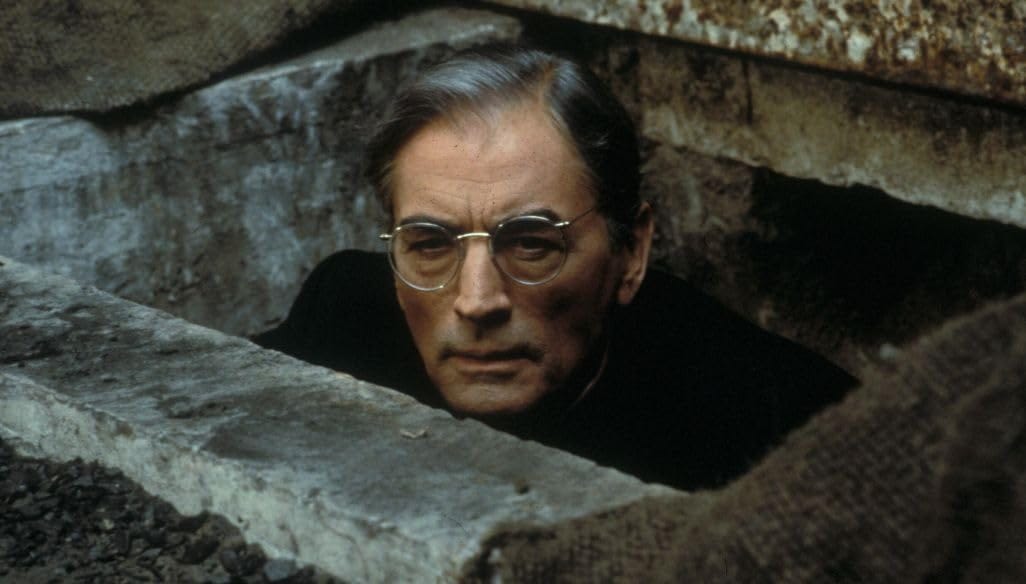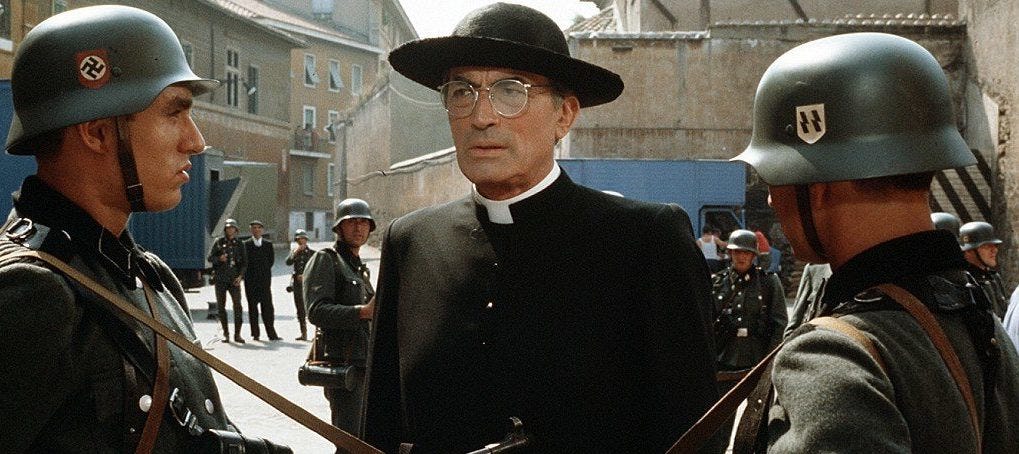The FFFEYIBA Project—1983
“Every month, year in and year out, O'Flaherty came to see him. In 1959, the former head of the dreaded Gestapo in Rome was baptized into the Catholic faith at the hand of the Irish priest.”
For a reminder on the purpose (and rules) of the project, see this post.
HM #1: The Right Stuff
Fun (if long!) film with a great, great cast. I don’t remember liking it quite as much as Roger Ebert did—the film’s impressive Rotten Tomatoes score doesn’t match up with my mostly-positive reaction—but I certainly enjoy its rousing account of a truly remarkable and fascinating historical moment. It was nominated for a boatload (rocket-ship?) of Oscars, and won four. Most notably, it won a little gold statue for my favorite part of the film: Bill Conti’s muscular, melodic score, previously written by Pyotr Ilyich Tchaikovsky. Yes, you heard correctly; written by Tchaikovksy. OK, yes, I’m exaggerating, but only by a little. Try listening to THIS. And then, THIS. Also, just to be clear, I don’t mean this as a criticism. After all, “everything’s a remix.”
HM #2: Sans Soleil
Described by the Criterion folks as the sui generis Chris Marker’s “mind-bending free-form travelogue that journeys from Africa to Japan,” this one will get under your skin, burrowing into the back of your mind and popping out from behind your subconscious when you least expect it. Again, I don’t mean this as a criticism. Marker’s a visual (and thematic) master, and will this one feels slightly less transgressive than La Jetée to me—“transgressive’s” not quite the right word, really, but I can’t quite think of a better way to describe Marker’s extraordinary ability to combine numerous non-cinematic pieces into a powerful, cinematic whole—but its still a powerful example of a work that make almost no sense on paper, but makes absolute sense on screen. (Jonathan Rosenbaum, whose wonderful essay, “Personal Effects: The Guarded Intimacy of Sans Soleil,” describes the film as “a cinematic essay and travel film made up of asides and digressions that form a portrait of late twentieth-century civilization,” notes that Marker “typically assigns himself the credit ‘filmmaker,’ not ‘director.’” That’s an enlightening distinction.)
And now, the moment you’ve all been waiting for (he says, hopefully).
1983’s Selection: The Scarlet and the Black, by Jerry London
Yes, this one’s a TV movie, but I’m going to allow it. It’s the story of Monsignor Hugh O'Flaherty, the “Scarlet Pimpernel of the Vatican,” and his cat-and-mouse game with Obersturmbannführer Herbert Kappler, the head of the SS Sicherheitsdienst and Gestapo in Rome during the late stages of Germany’s WWII occupation. Lots of good stuff here, which is probably why it was nominated for a couple of Emmys (and won one). But let’s be honest: This film works (and is great) because the chemistry between Peck and Plummer works (and is great). With apologies to John Gielgud and Kenneth Colley, here’s really no higher reason to watch this one.
Also known as The Scarlet Pimpernel of the Vatican, The Scarlet and the Black tells the true story of a Holy Office notary who, during Nazi occupation of Rome, covertly ran an underground railroad for Jews, anti-Fascists, and escaped Allied POWs.
That summary comes from SDG, who notes in his reivew that “there is something a bit curious about seeing Plummer, so well known as the patriotic Austrian Captain von Trapp of The Sound of Music, wearing a swastika on his arm (you almost want him to start ripping Nazi flags in half).”
OK, I was wrong about there being no other reason but Plummer and Peck. Despite what SDG says in his review, I find Ennio Morricone’s propulsive score to be fantastically memorable, with hints of the Leone Trilogy and The Untouchables. I’m not sure there’s quite enough melodic material—so I guess I’m in agreement with SDG about the “thinness” criticism, at least—but the starkness feels like a feature, not a bug. That opening theme is just fantastic. Full stop.
It is possible that my opinion of the score is greatly influenced by its role in what I consider the most memorable scene in the whole film: The moment where O'Flaherty walks along the white boundary line that sets the Vatican apart from Nazi-controlled Rome. Peck’s monsignor paces back and forth, teasing and needling Kappler by dangling his feet just above the whitewashed cobbles. In a film that certainly has its share of grimness, this scene has the tone of a young child, teasing its sibling.
The impish look on Peck’s face—sitting there in the crosshairs as he goads Kappler on, daring him to take action and pull the trigger in spite of his orders—is just perfect.








Yup. The Scarlet and the Black is a great film telling a true story form the dark days of WWII in Rome. I agree, Peck and Plummer play their roles very well.